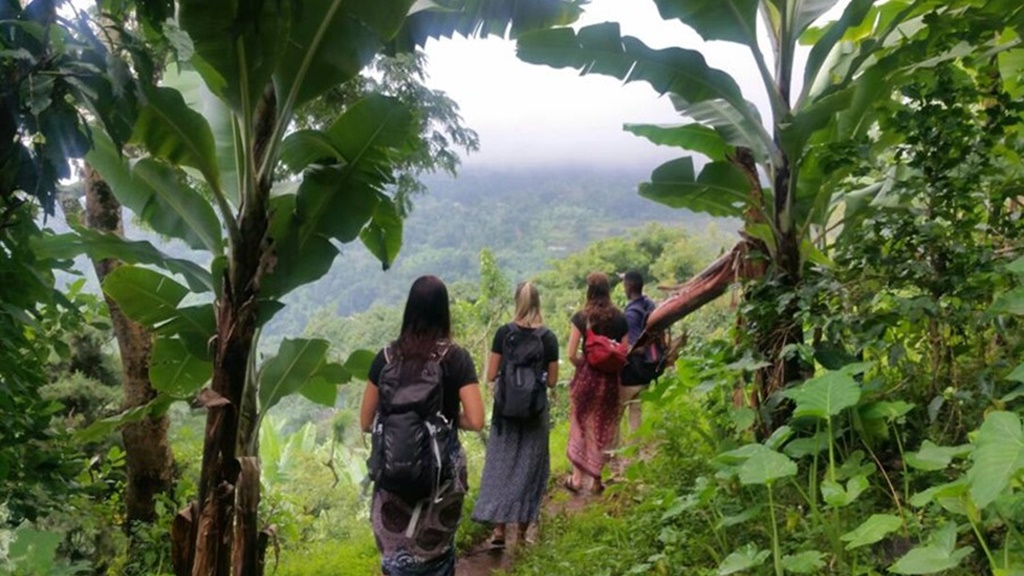Kwa Mambori Waterfall is located in the lush, verdant landscape of Komakya, roughly ten kilometres north of the bustling Moshi town. The area is characterized by its rolling hills, dense forests, and fertile valleys, all fed by the water sources originating from Africa’s highest peak, Mount Kilimanjaro. The waterfall itself is a spectacle of nature, where water cascades down a rugged cliff face into a series of natural pools, creating a misty, ethereal environment that captivates all who visit.
See also: Materuni Waterfalls and Coffee Tour
Nestled at the foot of the majestic Mount Kilimanjano, the Kwa Mambori Waterfalls stand as one of Tanzania’s most awe-inspiring natural wonders. With a dramatic drop of 80 meters, these falls are not just a scenic marvel but also a historical and cultural touchstone for the local communities of Old Moshi in the Moshi Rural district. This blog post delves deep into the allure of Kwa Mambori, exploring its natural beauty, historical significance, and the vibrant cultural tapestry that surrounds it.
History of Old Moshi’s Kwa Mambori
The region around Kwa Mambori has a rich historical tapestry woven from colonial times. Old Moshi, where the falls reside, was established by German settlers in the early 1890s. This area was once part of the German East Africa colony, and its history is marked by the resistance of local leaders like Chief Meli (Mangi Meli), who famously opposed German rule. His execution in 1900 is remembered through various historical sites near the falls, including the tree where he was hanged, now a sombre landmark.
Cultural Significance in Old Moshi
 The foundation of Old Moshi cultural tourism is Old Moshi, which is in the Kilimanjaro region and is home to the renowned Chagga Chiefs, the Mangi Meli-one, who dominated the area both before and during colonial times. The Germans founded Moshi town in 1893 at Old Moshi, which is 10 km north of the present-day Moshi town. The Germans constructed what is now Kolila Secondary School, a military installation. Situated 1,700–1,800 meters above sea level, the settlement offers picturesque views of Mount Kilimanjaro and Moshi town. The German military station offers a lot to see and learn, particularly about the architecture of the building, the cemetery, and the Chagga people’s resistance to Germany’s colonial conquest. Along with the Chagga history before and after colonialism, you will also experience a coffee tour, a climb to waterfalls, and traditional Chagga meals and beverages. After that, you’ll head back to your Moshi hotel.
The foundation of Old Moshi cultural tourism is Old Moshi, which is in the Kilimanjaro region and is home to the renowned Chagga Chiefs, the Mangi Meli-one, who dominated the area both before and during colonial times. The Germans founded Moshi town in 1893 at Old Moshi, which is 10 km north of the present-day Moshi town. The Germans constructed what is now Kolila Secondary School, a military installation. Situated 1,700–1,800 meters above sea level, the settlement offers picturesque views of Mount Kilimanjaro and Moshi town. The German military station offers a lot to see and learn, particularly about the architecture of the building, the cemetery, and the Chagga people’s resistance to Germany’s colonial conquest. Along with the Chagga history before and after colonialism, you will also experience a coffee tour, a climb to waterfalls, and traditional Chagga meals and beverages. After that, you’ll head back to your Moshi hotel.
- Old Moshi Cultural Tourism : This initiative supports local communities by promoting their rich cultural heritage. Visitors can engage with the history through guided tours that detail the German colonial past, the local Chagga culture, and the tragic story of Chief Meli.
- Cultural Sites:
- The Tree of Execution: Directly opposite what was once the German court, this tree stands as a silent witness to history.
- German Ruins: The remnants of military bases, chapels, and even a slave market provide a tangible connection to the past.
- Sacred Practices: The Msohu tree, used for traditional rituals, offers insight into the spiritual life of the Chagga people.
Adventures at Kwa Mambori

- Hiking:
- The trek to Kwa Mambori is an adventure in itself, starting from the village and descending through vibrant landscapes. The hike not only offers physical challenge but also a journey through time with stories from the guide about the falls’ origin and significance.
- Nature and Wildlife:
- The area around Kwa Mambori is teeming with life. Flora ranges from coffee and banana plantations to exotic plants, while fauna includes various species of birds, small mammals, and butterflies, making it a haven for nature enthusiasts.
- Photography:
- The scenic beauty of the falls, especially during the misty early mornings or late afternoons, provides endless photographic opportunities. The play of light through the mist at various times of the day creates a magical atmosphere perfect for photographers.
Visitor Information
- Getting There:
- By Foot: From Moshi town, take local transport to the Machame junction, then a 30-minute walk to the falls.
- By Bicycle: A more adventurous approach, cycling from Moshi takes about an hour to reach Komakya village, followed by a short walk.
- Guided Tour: Recommended for those who wish to delve deeper into the area’s history and culture. Tours often include transportation, guides, and sometimes meals.
- What to Bring:
- Hiking gear including sturdy shoes, rain protection, a day pack, water, sunblock, snacks, and a camera for capturing the memories.
- Tips for Visitors:
- Early visits are recommended for fewer crowds and better photographic conditions.
- Respect local customs, especially around sacred sites.
- Carry all waste back to maintain the pristine nature of the site.
Community and Conservation
The presence of Kwa Mambori has spurred local conservation efforts to preserve this natural wonder while promoting sustainable tourism. The revenue from tourism supports local infrastructure, education, and cultural preservation projects, ensuring that the benefits of such a natural asset are felt by the community.
More that a scenic spot
Kwa Mambori Waterfalls are more than just a scenic spot; they are a confluence of natural beauty, historical depth, and cultural richness. Visiting this site not only offers an escape into nature’s embrace but also an opportunity to connect with Tanzania’s layered history and vibrant local culture. Whether you’re an adventurer, a historian, or simply someone in search of peace, Kwa Mambori offers layers of experience that enrich the soul. Plan your visit to this hidden gem, where the past meets the present against the backdrop of one of Africa’s most iconic natural landscapes.
- Materuni Waterfalls from Arusha
- Top Airbnb Stays in Moshi to combine with Mount Kilimanjaro Treks
- Coffee Tours in the Kilimanjaro Region
- Visit the Machame Village – For Cultural Tours, Hikes, and Machame Language History
- Marangu Town: A Vibrant Cultural Village at the Foothills of Mount Kilimanjaro
![]()




Comments